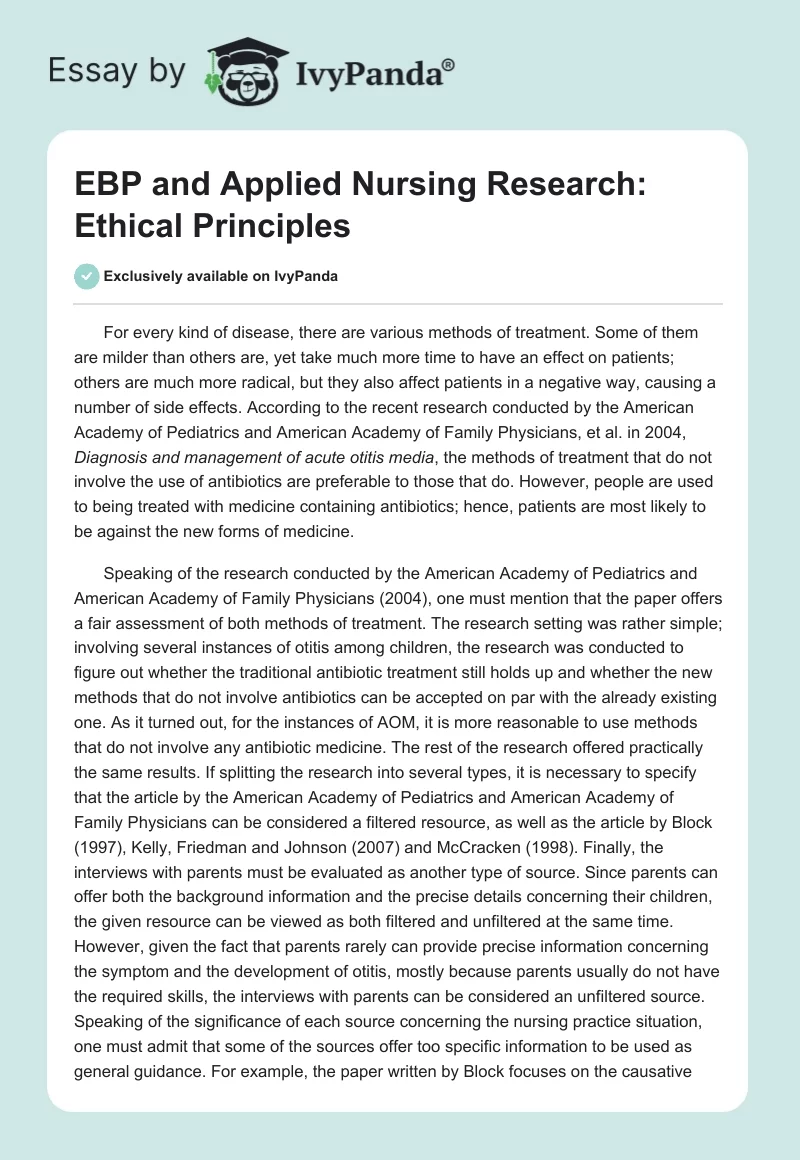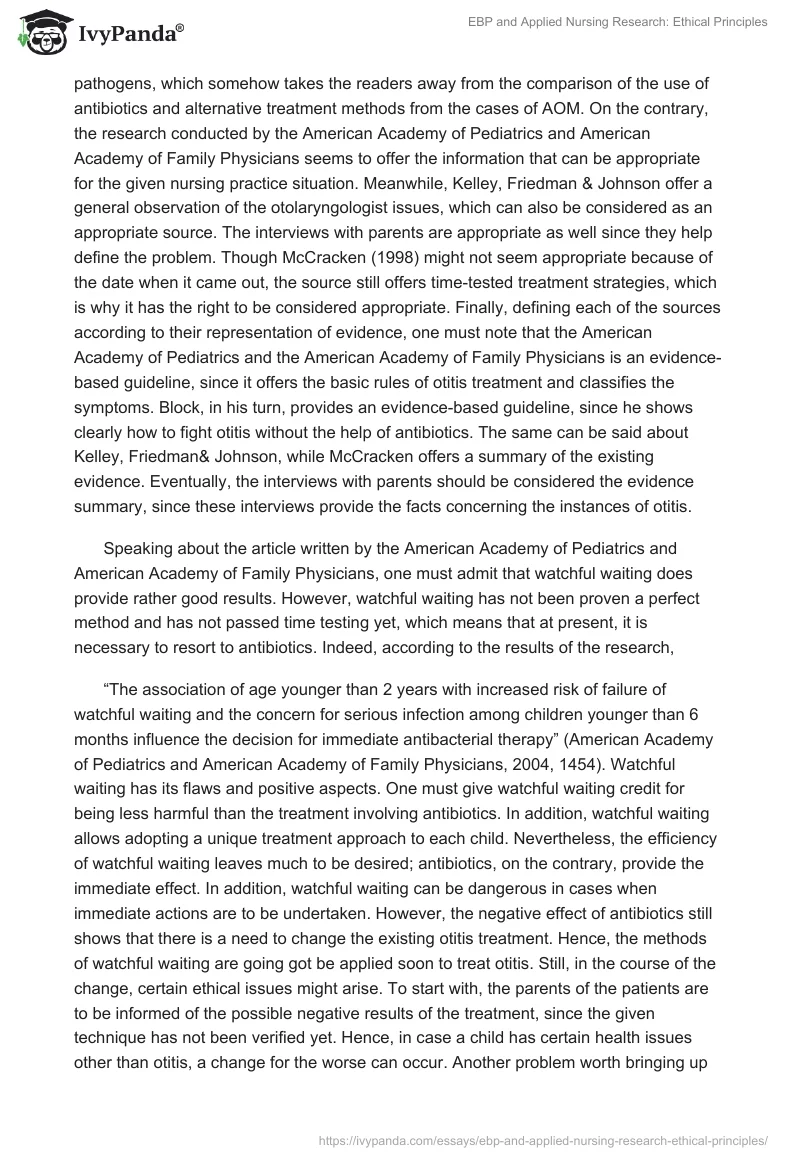For every kind of disease, there are various methods of treatment. Some of them are milder than others are, yet take much more time to have an effect on patients; others are much more radical, but they also affect patients in a negative way, causing a number of side effects. According to the recent research conducted by the American Academy of Pediatrics and American Academy of Family Physicians, et al. in 2004, Diagnosis and management of acute otitis media, the methods of treatment that do not involve the use of antibiotics are preferable to those that do. However, people are used to being treated with medicine containing antibiotics; hence, patients are most likely to be against the new forms of medicine.
Speaking of the research conducted by the American Academy of Pediatrics and American Academy of Family Physicians (2004), one must mention that the paper offers a fair assessment of both methods of treatment. The research setting was rather simple; involving several instances of otitis among children, the research was conducted to figure out whether the traditional antibiotic treatment still holds up and whether the new methods that do not involve antibiotics can be accepted on par with the already existing one. As it turned out, for the instances of AOM, it is more reasonable to use methods that do not involve any antibiotic medicine. The rest of the research offered practically the same results. If splitting the research into several types, it is necessary to specify that the article by the American Academy of Pediatrics and American Academy of Family Physicians can be considered a filtered resource, as well as the article by Block (1997), Kelly, Friedman and Johnson (2007) and McCracken (1998). Finally, the interviews with parents must be evaluated as another type of source. Since parents can offer both the background information and the precise details concerning their children, the given resource can be viewed as both filtered and unfiltered at the same time. However, given the fact that parents rarely can provide precise information concerning the symptom and the development of otitis, mostly because parents usually do not have the required skills, the interviews with parents can be considered an unfiltered source. Speaking of the significance of each source concerning the nursing practice situation, one must admit that some of the sources offer too specific information to be used as general guidance. For example, the paper written by Block focuses on the causative pathogens, which somehow takes the readers away from the comparison of the use of antibiotics and alternative treatment methods from the cases of AOM. On the contrary, the research conducted by the American Academy of Pediatrics and American Academy of Family Physicians seems to offer the information that can be appropriate for the given nursing practice situation. Meanwhile, Kelley, Friedman & Johnson offer a general observation of the otolaryngologist issues, which can also be considered as an appropriate source. The interviews with parents are appropriate as well since they help define the problem. Though McCracken (1998) might not seem appropriate because of the date when it came out, the source still offers time-tested treatment strategies, which is why it has the right to be considered appropriate. Finally, defining each of the sources according to their representation of evidence, one must note that the American Academy of Pediatrics and the American Academy of Family Physicians is an evidence-based guideline, since it offers the basic rules of otitis treatment and classifies the symptoms. Block, in his turn, provides an evidence-based guideline, since he shows clearly how to fight otitis without the help of antibiotics. The same can be said about Kelley, Friedman& Johnson, while McCracken offers a summary of the existing evidence. Eventually, the interviews with parents should be considered the evidence summary, since these interviews provide the facts concerning the instances of otitis.
Speaking about the article written by the American Academy of Pediatrics and American Academy of Family Physicians, one must admit that watchful waiting does provide rather good results. However, watchful waiting has not been proven a perfect method and has not passed time testing yet, which means that at present, it is necessary to resort to antibiotics. Indeed, according to the results of the research,
“The association of age younger than 2 years with increased risk of failure of watchful waiting and the concern for serious infection among children younger than 6 months influence the decision for immediate antibacterial therapy” (American Academy of Pediatrics and American Academy of Family Physicians, 2004, 1454). Watchful waiting has its flaws and positive aspects. One must give watchful waiting credit for being less harmful than the treatment involving antibiotics. In addition, watchful waiting allows adopting a unique treatment approach to each child. Nevertheless, the efficiency of watchful waiting leaves much to be desired; antibiotics, on the contrary, provide the immediate effect. In addition, watchful waiting can be dangerous in cases when immediate actions are to be undertaken. However, the negative effect of antibiotics still shows that there is a need to change the existing otitis treatment. Hence, the methods of watchful waiting are going got be applied soon to treat otitis. Still, in the course of the change, certain ethical issues might arise. To start with, the parents of the patients are to be informed of the possible negative results of the treatment, since the given technique has not been verified yet. Hence, in case a child has certain health issues other than otitis, a change for the worse can occur. Another problem worth bringing up is the fact that the target group belongs to the so-called vulnerable population since the participants of the research are children. Last, but not least, the issue of confidentiality must be mentioned. Since the group will consist of more than one family, the information about the patient must be available only to his/her parents. Hence, the latter is not to inform the parents of other patients about the changes in the patients’ health, treatment, etc.
The above-mentioned ideas should be put into practice to prove the efficiency of watchful waiting. Moreover, it is important that watchful waiting should be used together with antibiotic treatment. As has been mentioned above, the given methods complement each other. While watchful waiting will help develop a more complex approach towards solving the problem and reduce the negative effect of antibiotics, the latter can provide a faster recovery. Therefore, in practice, it is desirable that both methods should be combined.
Hence, it can be considered that the research conducted by the American Academy of Pediatrics and American Academy of Family Physicians is a daring and innovative paper that explores new opportunities in medicine. Analyzing the issue, the authors deal not only with the problem of acute otitis media, but the American Academy of Pediatrics and American Academy of Family Physicians also make it obvious that there are little to no studies proving the efficiency of treating AOM without the use of antibiotics. At the same time, the research offers sufficient proof to the theory that AOM should be handled with the help of less powerful types of medicine. Hence, one must concede that alternative treatment has the right to exist, though it definitely needs more time testing.
References
American Academy of Pediatrics and American Academy of Family Physicians. (2004.) Clinical practice guideline: Diagnosis and management of acute otitis media. Web.
Block, S. L. (1997). Causative pathogens, antibiotic resistance and therapeutic considerations in acute otitis media. Pediatric Infectious Disease Journal, 16, 449–456.
Kelley, P. E., Friedman, N., Johnson, C. (2007). Ear, nose, and throat. In W. W. Hay, M. J. Levin, J. M. Sondheimer, & R. R. Deterding (Eds.), Current pediatric diagnosis and treatment, 18th ed. (pp. 459–492). New York: Lange Medical Books/McGraw-Hill.
McCracken, G. H. (1998). Treatment of acute otitis media in an era of increasing microbial resistance. Pediatric Infectious Disease Journal, 17, 576–579.


